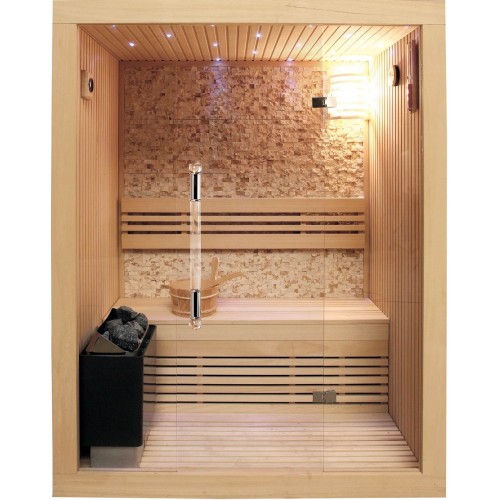The Basic Principles Of Traditional Sauna
The Basic Principles Of Traditional Sauna
Blog Article
The smart Trick of Traditional Sauna That Nobody is Talking About
Table of ContentsAll About Traditional Sauna7 Easy Facts About Traditional Sauna ExplainedTraditional Sauna Can Be Fun For Everyone6 Simple Techniques For Traditional Sauna
A lot of the weight lost in a sauna is water loss and is re-gained upon rehydrating. However, without an uncertainty sauna can be an integral part of a healthy and balanced weight loss program. To check out the distinctions in between traditional and IR saunas, I will certainly divide these into verifiable, academic, and made differences.Hence, the hottest point in the saunawhich is at the ceiling directly over the sauna heateris commonly in between 185 and 190 F. Traditional Sauna. Claims that a typical sauna surpasses 200 F is simply not real and not applicable for electric saunas marketed in the United States. The temperature for a far-infrared sauna is usually established in between 120 and 140 F; nonetheless, unlike the conventional sauna, the goal in and IR space is not to achieve a heat
Due to this, the temperature level difference is practically irrelevant, given that excessive sweating causes both sauna kinds, however the technique of warming the body is various. In an IR sauna the bather will feel warm and will sweat profusely, yet at much lower temperature levels. Hence, if the objective is to spend longer durations of time in the sauna, the IR sauna is a great option.

Some Known Incorrect Statements About Traditional Sauna
When the high temperature level is accomplished, the elements cycle on and off to preserve the high temperature level. A lot of traditional sauna individuals enjoy pouring water over the rocks to create steam to increase sauna moisture degrees. The benefits of putting water over the rocks consist of: making the area extra comfy, dampening the nasal flows, and allowing the use of aromatherapy by blending vital oils with the water.
In a far-infrared sauna, the warm front permeate the body to efficiently heat up the body and raise the body core temperature level. To accomplish this raised temperature level, Far-infrared emitters develop infrared energy which is close to the very same wavelength as that which the body normally emitsoften described as the "Essential Range" of 7 to 14 microns), so the power is well received by the body.
When the energy enters the body, it creates the body temperature to increase and inevitably results in perspiration. In an infrared sauna it is necessary for the emitters/heaters to remain on nearly regularly. Since there is no mass of rocks to preserve heat, the sauna will certainly cool down if the emitters turned off.
As discussed above, the sauna bather in an infrared space wishes to position himself before running emitters to get maximum gain from the warm. The heating time for the two spaces can be really different, relying on how the rooms are utilized. For a conventional sauna, a bather must permit 30-40 mins for the space to achieve a desired temperature and to properly pre-heat the rocks.
Get This Report on Traditional Sauna
A well built sauna will typically attain a temperature of 150-160 F in about 30-40 mins (Traditional Sauna). For hotter temperature levels, the room might need to heat for a longer period. Once the room attains established temperature level, the heater will cycle on and off, normally running about 50% of the moment. The protected walls and the warmed rocks will maintain the space hot and at stable temperatures.
To some, 15 mins was "squandered" while the infrared power heated the wood panels as opposed to heating a body, while others find a pre-heated area to be a lot more comfortable and think an elevated beginning temperature level is needed to begin sweating. The length of recommended usage for go to website each room is roughly the very same (10-15 minutes per session); however, because of the lower air temperature levels and the capacity to feel the impacts of infrared heat quicker than a typical sauna, it is not unusual for a person to invest a total amount of 20-30 mins in an infrared sauna.
Typical saunas tend to be larger (hence use even more electrical energy) than infrared saunas, although traditional saunas are certainly available in one and two person sizes. For a two-person traditional sauna, 5x6 or 5x7 dimension is most preferred. The leading bench can conveniently seat 2 or 3 people and is additionally long enough to lie down during the sauna session.


The ordinary expense per kWH of electricity in the united state is around $0.11, so a 4.5 kW heating unit will certainly set you back about $.50 to compete one hour, if the heater runs continuously for one hour. Typically a sauna heating system will certainly run for 75% of the very first hour and 50% of succeeding hours on given that the aspects cycle once the set temperature level is accomplished.
The Ultimate Guide To Traditional Sauna
A 2 individual far-infrared space is usually literally smaller sized than a conventional sauna, usually regarding 4' x 4' or smaller. The IR furnace is usually 1.5-1.7 kW utilizing a 120 volt 15 amp plug-in solution. Considering that the space can be used faster than a sauna space, we will assume the room is more helpful hints utilized for to of an hour consisting of warm up time.
There is a hardly ever reviewed difference in the social experience in between the two spaces. While our society has shed several of the social benefit of the conventional sauna experience, it can be really socially satisfying. From household time in the sauna, to heart-felt discussions with loved ones, to sauna partiesthe standard sauna experience can cause intimate socializing.
The majority of greater end infrared rooms include Resources colored light therapy, noise systems and full-glass fronts.
Report this page